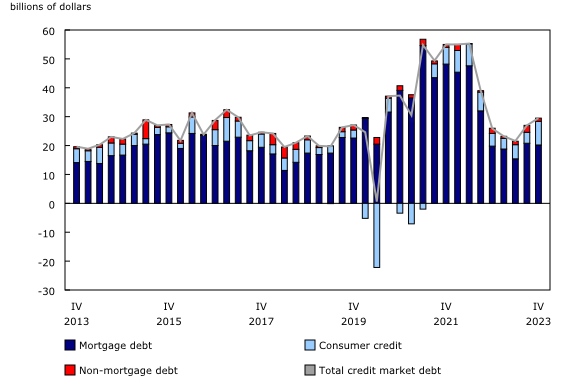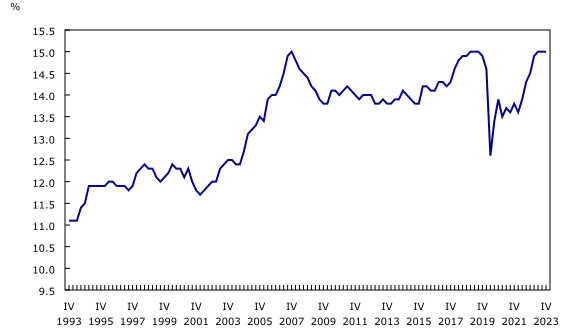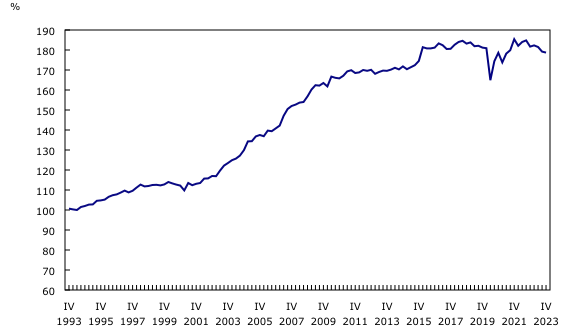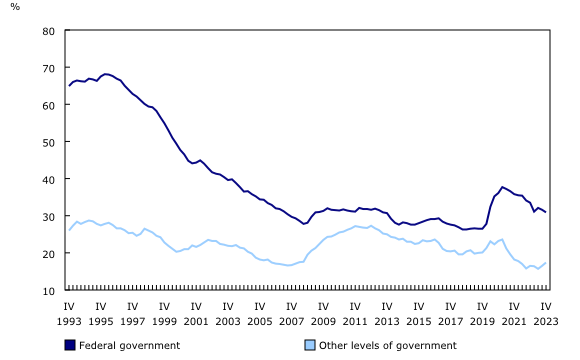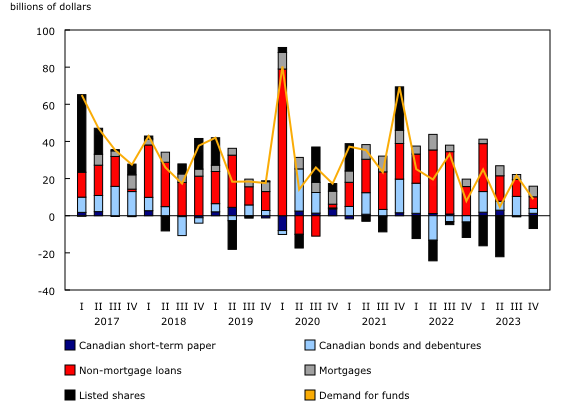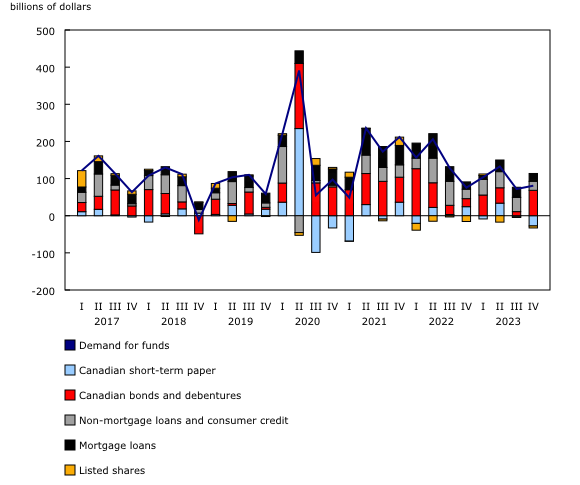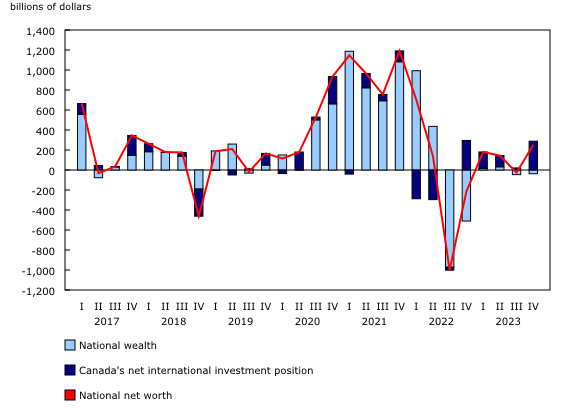National balance sheet and financial flow accounts, fourth quarter 2023
Released: 2024-03-13
Household net worth increases as rally in financial markets outweighs continued cooling in housing market
Households were wealthier in the fourth quarter as their net worth—the value of all assets minus all liabilities—increased $289.8 billion (+1.8%) to $16,419.9 billion. This increase was driven by strength in financial markets as both bonds and equities rallied after losing ground in the prior quarter. This pushed financial assets higher by nearly half a trillion dollars to a new record high of $9,741.3 billion, surpassing the previous record set in the fourth quarter of 2021. In the fourth quarter of 2023, this gain in financial assets was partially offset by a $157.8 billion decline in the value of residential real estate, the second consecutive quarterly decrease.
Over 2023, household financial assets increased 7.0% (+$636.7 billion) while non-financial assets increased a more modest 1.8% (+$174.4 billion). On the other side of the ledger, financial liabilities increased by 3.4% (+$98.4 billion) over the year, the slowest accumulation of household debt in a calendar year since 1990. The accumulation of assets and liabilities is not distributed evenly across wealth quintiles as most wealth is held by relatively few households in Canada.
Household saving rate remains resilient as household deposits and mutual fund shares finish the year strong
The household saving rate (seasonally adjusted) stood at 6.2% in the fourth quarter, little changed from the previous quarter and higher than the 5.6% recorded at the end of 2022.
Household sector holdings of currency and deposits finished the year strong, increasing by 2.4% (+$50.1 billion) in the fourth quarter of 2023 after rising $66.4 billion over the first three quarters of the year. During 2023, households accumulated $116.4 billion worth of currency and deposits, down from $174.5 billion in 2022. In comparison, the average annual accumulation of deposits from 2010 to 2019 was roughly $64 billion.
Households recorded $11.8 billion in net acquisitions of mutual fund shares in the fourth quarter of 2023. This accounted for nearly all the positive mutual fund inflows for the year, as households recorded an overall net outflow over the first three quarters of 2023. While non-money market mutual funds have posted substantial net outflows since the middle of 2022, exchange-traded funds and money market funds have proven to be popular choices for household investment, recording the largest net inflows of funds over this period. This may imply that consumers are focusing on shorter investment time horizons and seeking potentially lower fee structures.
Highlights
The Canadian economy grew during the fourth quarter after declining in the third quarter as increases in net exports were slightly offset by declines in business investment. Higher energy exports and lower imports of intermediate manufacturing products and passenger vehicles fuelled the increase in net exports, while capital investment was hampered by lower expenditures on engineering structures. According to data from the Canadian Survey on Business Conditions, businesses continued to expect to face a variety of obstacles: primarily cost-related obstacles such as rising inflation and rising cost of inputs.
The household saving rate remained almost unchanged in the fourth quarter as disposable income and household consumption rose at roughly the same rate. The policy interest rate was held at 5% for the fifth consecutive rate announcement by the Bank of Canada, while household mortgage borrowing activity was up slightly from the third quarter, following a slower pace in the first half of 2023. In the fourth quarter, consumers demonstrated more reservations regarding their future spending plans given economic uncertainty, persistent inflation, and elevated interest rates.
Financial markets for bonds and equities, both foreign and domestic, rallied in the fourth quarter, bringing household net worth higher. This increase was tempered by the housing market as real estate valuations continued to recede. Federal government credit market borrowing increased as it issued a larger amount of bonds than it retired alongside net retirements of short-term paper. Canada's net foreign asset position improved as strong foreign financial markets boosted the value of Canadian investments abroad despite a stronger Canadian dollar.
Residential real estate recedes as resale activity moderates
The value of household residential real estate decreased 1.9% in the fourth quarter, the second consecutive decline. The Canadian housing market faced significant headwinds in 2022: real estate values fell 6.8% on an annual basis and the Bank of Canada's rate-hike cycle put upward pressure on borrowing costs. By the beginning of 2023, the Canadian housing market showed signs of recovery before slowing in the third and fourth quarter, resulting in an overall increase of 1.8% over the year.
In the fourth quarter, on a seasonally adjusted basis, both the value of resale homes sold (-8.9%) and the number of units sold (-7.7%) were down from the third quarter. However, the value of resales (+3.4%) and the number of sales (0.8%) were both higher in the fourth quarter of 2023 compared with the fourth quarter of 2022. On a quarterly basis, housing investment edged up (+0.1%) in the fourth quarter of 2023 as increases in new construction activity (+3.4%) and renovations (+1.4%) were more than offset by a drop in ownership transfer costs (-9.8%) stemming from the slowdown in resale activity.
Seasonally adjusted consumer credit spikes
During the fourth quarter, the pace of household credit market borrowing (seasonally adjusted) continued to rise, reaching $29.5 billion, a second consecutive quarterly increase following four consecutive quarters of weaker borrowing. The increased demand for funds was spurred by households seeking consumer credit (+$8.2 billion), the second largest net origination of consumer credit since 2009. Aside from consumer credit, other forms of credit market debt (including mortgages) declined by $1.9 billion.
Household debt service ratio largely unchanged
The household debt service ratio, measured as total obligated payments of principal and interest on credit market debt as a proportion of household disposable income, rose slightly to 15.00% in the fourth quarter from 14.99% in the third quarter (revised from 15.22%), as debt payments and household disposable income both rose by approximately 1.3%.
From the start of 2022, when the Bank of Canada began raising interest rates, to the end of 2023, mortgage interest payments almost doubled (+97.2%). By the fourth quarter of 2023, mortgage interest represented 66.2% of total mortgage debt payments, up from 45.8% in the fourth quarter of 2021. Meanwhile, following steady declines during 2022, mortgage principal payments stabilized and, in the fourth quarter of 2023, stood at $12.4 billion for the second consecutive quarter.
On a seasonally adjusted basis, household credit market debt as a proportion of household disposable income declined for the third consecutive quarter, from 179.2% in the third quarter to 178.7% in the fourth quarter, as household disposable income (+1.3%) outpaced the growth in credit market debt (+1.0%) because of relatively slow mortgage borrowing in the fourth quarter. In other words, there was $1.79 in credit market debt for every dollar of household disposable income in the fourth quarter.
Cost to replace maturing government debt remains elevated
In the fourth quarter, the federal government borrowed $22.0 billion in bonds and treasury bills, a notable increase from the $12.2 billion recorded in the third quarter. The fourth quarter borrowing primarily consisted of net issuances of bonds (+$27.6 billion), which were partially offset by net redemptions of treasury bills (-$5.7 billion). Overall, the federal government shifted away from short-term instruments, which it had favoured over the five previous quarters. At the start of the fourth quarter, yields reached their highest level in the last two decades, but moved lower by the end of the fourth quarter. Despite this, the effective interest cost on federal government debt persisted at elevated rates as the cost to replace maturing debt remained high.
The ratio of federal government net financial liabilities to gross domestic product eased to 30.9% in the fourth quarter from 31.6% in the third quarter owing to positive economic growth, as well as growth in financial assets (+4.5%) outpacing that of liabilities (+1.8%).
Private non-financial corporations' demand for funds declines as listed share redemptions continue
The demand for funds by private non-financial corporations fell to $8.9 billion in the fourth quarter from $21.7 billion in the third quarter. The decline was concentrated in bonds (-$7.9 billion), as net issuances slowed substantially in the fourth quarter, and in listed shares (-$6.6 billion), which saw eight consecutive quarters of net redemptions totalling $79.0 billion over this eight-quarter period. Over the course of 2023, private non-financial corporations' demand for funds was $60.3 billion, a decline from $85.7 billion in the previous year.
Record growth in Canada's international assets buoys national net worth
National net worth, the sum of national wealth and Canada's net foreign asset position, rose $251.0 billion in the fourth quarter despite a decline in national wealth. Canada's national net worth was driven by growth in the international investment position (+20.7%), fuelled by the strength of global equity markets. Specifically, Canada's international financial assets were up by $613.1 billion (+7.3%) to $9,037.6 billion at the end of the fourth quarter, the highest quarterly increase on record. Moreover, Canada's international liabilities were up $324.9 billion to $7,360.3 billion, also reporting the largest quarterly increase on record. Over the last five quarters, the international investment position has increased by $879.8 billion.
The total value of non-financial assets in Canada, also referred to as national wealth, edged down 0.2% in the fourth quarter to $16,821.3 billion. Residential real estate once again dropped, falling $166.1 billion, as house prices continued to decline. Conversely, the value of subsoil assets, consisting of energy and mineral reserves, increased by $68.9 billion, largely on account of elevated gold and uranium prices.
Did you know we have a mobile app?
Get timely access to data right at your fingertips by downloading the StatsCAN app, available for free on the App Store and on Google Play.
Note to readers
Revisions
This release of the national balance sheet and financial flow accounts for the fourth quarter of 2023, includes revised estimates for the first quarter to the third quarter of 2023. These data incorporate new and revised data, as well as updated data on seasonal trends.
Data enhancements to the national balance sheet and financial flow accounts, such as the development of detailed counterparty information by sector, will be incorporated on an ongoing basis. To facilitate this initiative as well as others, it is necessary to extend the annual revision period (normally the previous three years) at the time of the third quarter release.
Details on these revisions are available in "An overview of revisions to the Financial and Wealth Accounts, 1990 to 2023."
General
Unless otherwise stated, growth rates represent the percentage change in the series from one quarter to the next; for instance, from the third quarter of 2023 to the fourth quarter of 2023.
Unless otherwise stated, this release presents data unadjusted for seasonality.
Support measures by governments
Details on some of the more significant federal government COVID-19 support measures are now available in table 36-10-0687: Federal government COVID-19 response measures in the System of Macroeconomic Accounts, quarterly.
Financial and wealth accounts on a from-whom-to-whom basis: Selected financial instruments
The data visualization product "Financial accounts on a from-whom-to-whom basis, selected financial instruments" has been updated with data from the first quarter to the fourth quarter of 2023.
Next release
Data on the national balance sheet and financial flow accounts for the first quarter of 2024 will be released on June 13, 2024.
Overview of the financial and wealth accounts
This release of the financial and wealth accounts comprises the national balance sheet accounts (NBSA), the financial flow accounts (FFA), and the other changes in assets account.
The NBSA are composed of the balance sheets of all sectors and subsectors of the economy. The main sectors are households, non-profit institutions serving households, financial corporations, non-financial corporations, government, and non-residents. The NBSA cover all national non-financial assets and all financial asset-liability claims outstanding in all sectors. To improve the interpretability of financial flows data, selected household borrowing series are available on a seasonally adjusted basis (table 38-10-0238-01). All other data are unadjusted for seasonal variation. For information on seasonal adjustment, see Seasonally adjusted data – Frequently asked questions.
The FFA articulate net lending or borrowing activity by sector by measuring financial transactions in the economy. The FFA arrive at a measure of net financial investment, which is the difference between transactions in financial assets and liabilities (for example, net purchases of securities less net issuances of securities). The FFA also provide the link between financial and non-financial activity in the economy, which ties estimates of saving and non-financial capital acquisition (for example, investment in new housing) to the underlying financial transactions.
While the FFA record changes in financial assets and liabilities between opening and closing balance sheets that are associated with transactions during the accounting period, the value of assets and liabilities held by an institution can also change for other reasons. These other types of changes, referred to as other economic flows, are recorded in the other changes in assets account.
There are two main components to this account. One is the other changes in the volume of assets account. This account includes changes in non-financial and financial assets and liabilities relating to the economic appearance and disappearance of assets, the effects of external events such as wars or catastrophes on the value of assets, and changes in the classification and structure of assets. The other main component is the revaluation account, showing holding gains or losses accruing to the owners of non-financial and financial assets and liabilities during the accounting period as a result of changes in market price valuations.
At present, only the aggregate other change in assets is available within the Canadian System of Macroeconomic Accounts; no details are available on the different components.
Definitions concerning financial indicators can be found in "Financial indicators from the National Balance Sheet Accounts" and in the Canadian System of Macroeconomic Accounts glossary.
Distributions of household economic accounts
The NBSA for the household sector is allocated across a number of socioeconomic dimensions as part of the distributions of household economic accounts. Data on wealth and its components by income quintile, age group, generation and region are available in tables 36-10-0660-01, 36-10-0661-01, 36-10-0664-01, and 36-10-0665-01.
The methodology for Distributions of household economic accounts wealth estimates can be found in the article "Distributions of Household Economic Accounts, estimates of asset, liability and net worth distributions, 2010 to 2023, technical methodology and quality report."
Products
The document, "An overview of revisions to the Financial and Wealth Accounts, 1990 to 2023," which is part of Latest Developments in the Canadian Economic Accounts (13-605-X), is available.
The data visualization product "Financial accounts on a from-whom-to-whom basis, selected financial instruments," which is part of Statistics Canada – Data Visualization Products (71-607-X), is available.
As a complement to this release, you can also consult the data visualization product "Distributions of Household Economic Accounts, Wealth: Interactive tool," which is part of Statistics Canada – Data Visualization Products (71-607-X).
As a complement to this release, you can also consult the data visualization product "Securities statistics," which is part of Statistics Canada – Data Visualization Products (71-607-X).
The Economic accounts statistics portal, accessible from the Subjects module of our website, features an up-to-date portrait of national and provincial economies and their structure.
The User Guide: Canadian System of Macroeconomic Accounts (13-606-G) is available.
The Methodological Guide: Canadian System of Macroeconomic Accounts (13-607-X) is available.
The Canada: Economic and Financial Data - International Monetary Fund's Special Data Dissemination Standard Plus product (13-608-X), "Other Financial Corporations Survey," also known as "Assets and liabilities of other financial corporations by sector, market value, quarterly" (36-10-0668-01), are available.
Contact information
For more information, or to enquire about the concepts, methods or data quality of this release, contact us (toll-free 1-800-263-1136; 514-283-8300; infostats@statcan.gc.ca) or Media Relations (statcan.mediahotline-ligneinfomedias.statcan@statcan.gc.ca).
- Date modified:


